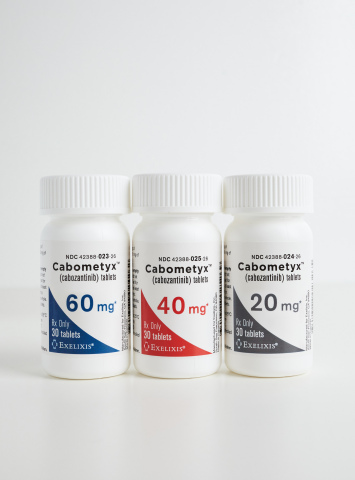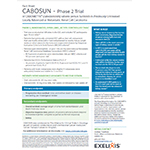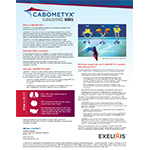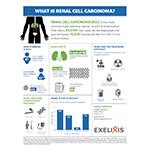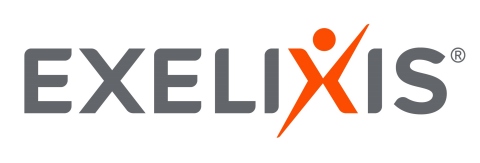SOUTH SAN FRANCISCO, Calif.--(BUSINESS WIRE)--Exelixis, Inc. (NASDAQ:EXEL) today announced that the U.S. Food and Drug Administration (FDA) approved CABOMETYX® (cabozantinib) tablets for the expanded indication of patients with advanced renal cell carcinoma (RCC). RCC is the most common form of kidney cancer in adults. The FDA’s priority review and approval of CABOMETYX was based on results from the randomized phase 2 CABOSUN trial in patients with previously untreated RCC, which demonstrated a statistically significant and clinically meaningful improvement in progression-free survival (PFS) versus sunitinib, a current standard of care. Today’s label expansion follows the initial FDA approval of CABOMETYX in April 2016 for the treatment of patients with advanced RCC who have previously received anti-angiogenic therapy.
“Today’s approval of CABOMETYX is a true win for patients in the U.S. with advanced renal cell carcinoma who now have a new first-line treatment option,” said Michael M. Morrissey, Ph.D., President and Chief Executive Officer of Exelixis. “We are very pleased with the expanded indication and are prepared to bring CABOMETYX to all eligible patients who may benefit from this important treatment option starting today. I would like to sincerely thank the patients and clinicians who participated in the CABOSUN trial, the Alliance and NCI-CTEP, as well as our dedicated clinical, medical and regulatory teams for their tireless efforts to this end. We would also like to acknowledge the review team at FDA for their expeditious review of our application.”
“The CABOSUN trial enrolled treatment-naïve patients with advanced kidney cancer, including those who are known to fare poorly, such as patients with intermediate- or poor-prognostic factors and those with bone metastases or multiple sites of metastatic disease,” said Toni Choueiri, M.D., Director, Lank Center for Genitourinary Oncology, Dana-Farber Cancer Institute. “Physicians are already experienced in using CABOMETYX in the second-line advanced RCC setting, and it is a much-needed advance to also now have CABOMETYX as an option for their patients with previously untreated advanced RCC.”
The expanded approval of CABOMETYX is based on results of the phase 2 CABOSUN trial, which met its primary endpoint of improving PFS. According to the independent radiology review committee analysis of the data, CABOMETYX demonstrated a clinically meaningful and statistically significant 52 percent reduction in the rate of disease progression or death (HR 0.48, 95% CI 0.31-0.74, two-sided P=0.0008). Median PFS for CABOMETYX was 8.6 months versus 5.3 months for sunitinib, corresponding to a 3.3 month (62 percent) improvement.
All causality grade 3 or 4 adverse reactions occurred in 68 percent of patients receiving CABOMETYX and 65 percent of patients receiving sunitinib. The most frequent all causality Grade 3-4 adverse reactions (≥5 percent) in patients treated with CABOMETYX were hypertension, diarrhea, hyponatremia, hypophosphatemia, palmar-plantar erythrodysesthesia (PPE), fatigue, increased ALT, decreased appetite, stomatitis, pain, hypotension, and syncope. Twenty-one percent of patients in the CABOMETYX arm compared to 22 percent of patients receiving sunitinib discontinued treatment due to adverse events.
“We at the Alliance for Clinical Trials in Oncology are very gratified that the CABOSUN study supported the approval of CABOMETYX for the potential first-line treatment of all patients with advanced renal cell carcinoma. This trial exemplifies how NCI-sponsored studies can be efficient, accrue rapidly, and yield results highly relevant to the field,” said Michael J. Morris, M.D., medical oncologist at Memorial Sloan Kettering Cancer Center, and Chair of the Alliance Genitourinary (GU) Committee.
Please see Important Safety Information below and full U.S. prescribing information at https://cabometyx.com/downloads/cabometyxuspi.pdf.
About the CABOSUN Study
On May 23, 2016, Exelixis announced that CABOSUN met its primary endpoint, demonstrating a statistically significant and clinically meaningful improvement in PFS compared with sunitinib in patients with advanced intermediate- or poor-risk RCC as determined by investigator assessment. The CABOSUN study was conducted by The Alliance for Clinical Trials in Oncology and was sponsored by the National Cancer Institute-Cancer Therapy Evaluation Program (NCI-CTEP) under the Cooperative Research and Development Agreement with Exelixis for the development of cabozantinib. These results were first presented by Dr. Toni Choueiri at the European Society for Medical Oncology (ESMO) 2016 Congress, and published in the Journal of Clinical Oncology (Choueiri, JCO, 2016).1 In June 2017, a blinded independent radiology review committee (IRC) confirmed that cabozantinib provided a clinically meaningful and statistically significant improvement in the primary efficacy endpoint of investigator-assessed PFS. Results from the IRC review were presented by Dr. Toni Choueiri at the ESMO 2017 Congress.
CABOSUN was a randomized, open-label, active-controlled phase 2 trial that enrolled 157 patients with advanced RCC determined to be intermediate- or poor-risk by the IMDC criteria. Patients were randomized 1:1 to receive cabozantinib (60 mg once daily) or sunitinib (50 mg once daily, 4 weeks on followed by 2 weeks off). The primary endpoint was PFS. Secondary endpoints included overall survival, objective response rate and safety. Eligible patients were required to have locally advanced or metastatic clear-cell RCC, ECOG performance status 0-2 and had to be intermediate or poor risk per the IMDC criteria (Heng, JCO, 2009).2 Prior systemic treatment for RCC was not permitted.
About Advanced Renal Cell Carcinoma
The American Cancer Society’s 2017 statistics cite kidney cancer as among the top ten most commonly diagnosed forms of cancer among both men and women in the U.S.3 Clear cell RCC is the most common type of kidney cancer in adults.4 If detected in its early stages, the five-year survival rate for RCC is high; for patients with advanced or late-stage metastatic RCC, however, the five-year survival rate is only 12 percent, with no identified cure for the disease.3 Approximately 30,000 patients in the U.S. and 68,000 globally require treatment, and an estimated 14,000 patients in the U.S. each year are in need of a first-line treatment for advanced kidney cancer.5
The majority of clear cell RCC tumors have lower than normal levels of a protein called von Hippel-Lindau, which leads to higher levels of MET, AXL and VEGF.6,7 These proteins promote tumor angiogenesis (blood vessel growth), growth, invasiveness and metastasis.8-11 MET and AXL may provide escape pathways that drive resistance to VEGF receptor inhibitors.7,8
About CABOMETYX® (cabozantinib)
CABOMETYX tablets are approved in the United States for the treatment of patients with advanced RCC. CABOMETYX tablets are also approved in the European Union, Norway, Iceland and Switzerland for the treatment of advanced RCC in adults who have received prior vascular endothelial growth factor (VEGF)-targeted therapy. Ipsen also submitted to European Medicines Agency (EMA) the regulatory dossier for cabozantinib as a treatment for first-line advanced RCC in the European Union on August 28, 2017; on September 8, 2017, Ipsen announced that the EMA validated the application. In 2016, Exelixis granted Ipsen exclusive rights for the commercialization and further clinical development of cabozantinib outside of the United States and Japan. In 2017, Exelixis granted exclusive rights to Takeda Pharmaceutical Company Limited for the commercialization and further clinical development of cabozantinib for all future indications in Japan, including RCC.
U.S. Important Safety Information
- Hemorrhage: Severe and fatal hemorrhages have occurred with CABOMETYX. In two RCC studies, the incidence of Grade ≥ 3 hemorrhagic events was 3% in CABOMETYX-treated patients. Do not administer CABOMETYX to patients that have or are at risk for severe hemorrhage.
- Gastrointestinal (GI) Perforations and Fistulas: In RCC studies, fistulas were reported in 1% of CABOMETYX-treated patients. Fatal perforations occurred in patients treated with CABOMETYX. In RCC studies, gastrointestinal (GI) perforations were reported in 1% of CABOMETYX-treated patients. Monitor patients for symptoms of fistulas and perforations, including abscess and sepsis. Discontinue CABOMETYX in patients who experience a fistula which cannot be appropriately managed or a GI perforation.
- Thrombotic Events: CABOMETYX treatment results in an increased incidence of thrombotic events. In RCC studies, venous thromboembolism occurred in 9% (including 5% pulmonary embolism) and arterial thromboembolism occurred in 1% of CABOMETYX-treated patients. Fatal thrombotic events occurred in the cabozantinib clinical program. Discontinue CABOMETYX in patients who develop an acute myocardial infarction or any other arterial thromboembolic complication.
- Hypertension and Hypertensive Crisis: CABOMETYX treatment results in an increased incidence of treatment-emergent hypertension, including hypertensive crisis. In RCC studies, hypertension was reported in 44% (18% Grade ≥ 3) of CABOMETYX-treated patients. Monitor blood pressure prior to initiation and regularly during CABOMETYX treatment. Withhold CABOMETYX for hypertension that is not adequately controlled with medical management; when controlled, resume CABOMETYX at a reduced dose. Discontinue CABOMETYX for severe hypertension that cannot be controlled with anti-hypertensive therapy. Discontinue CABOMETYX if there is evidence of hypertensive crisis or severe hypertension despite optimal medical management.
- Diarrhea: In RCC studies, diarrhea occurred in 74% of patients treated with CABOMETYX. Grade 3 diarrhea occurred in 11% of patients treated with CABOMETYX. Withhold CABOMETYX in patients who develop intolerable Grade 2 diarrhea or Grade 3-4 diarrhea that cannot be managed with standard antidiarrheal treatments until improvement to Grade 1; resume CABOMETYX at a reduced dose.
- Palmar-Plantar Erythrodysesthesia (PPE): In RCC studies, palmar-plantar erythrodysesthesia (PPE) occurred in 42% of patients treated with CABOMETYX. Grade 3 PPE occurred in 8% of patients treated with CABOMETYX. Withhold CABOMETYX in patients who develop intolerable Grade 2 PPE or Grade 3 PPE until improvement to Grade 1; resume CABOMETYX at a reduced dose.
- Reversible Posterior Leukoencephalopathy Syndrome (RPLS), a syndrome of subcortical vasogenic edema diagnosed by characteristic finding on MRI, occurred in the cabozantinib clinical program. Perform an evaluation for RPLS in any patient presenting with seizures, headache, visual disturbances, confusion or altered mental function. Discontinue CABOMETYX in patients who develop RPLS.
- Embryo-fetal Toxicity may be associated with CABOMETYX. Advise pregnant women of the potential risk to a fetus. Advise females of reproductive potential to use effective contraception during CABOMETYX treatment and for 4 months after the last dose.
- Adverse Reactions: The most commonly reported (≥25%) adverse reactions are: diarrhea, fatigue, nausea, decreased appetite, hypertension, PPE, weight decreased, vomiting, dysgeusia, and stomatitis.
- Strong CYP3A4 Inhibitors: If concomitant use with strong CYP3A4 inhibitors cannot be avoided, reduce the CABOMETYX dosage.
- Strong CYP3A4 Inducers: If concomitant use with strong CYP3A4 inducers cannot be avoided, increase the CABOMETYX dosage.
- Lactation: Advise women not to breastfeed while taking CABOMETYX and for 4 months after the final dose.
- Hepatic Impairment: In patients with mild to moderate hepatic impairment, reduce the CABOMETYX dosage. CABOMETYX is not recommended for use in patients with severe hepatic impairment.
Please see accompanying full Prescribing Information https://cabometyx.com/downloads/cabometyxuspi.pdf.
About Exelixis
Founded in 1994, Exelixis, Inc. (NASDAQ: EXEL) is a commercially successful, oncology-focused biotechnology company that strives to accelerate the discovery, development and commercialization of new medicines for difficult-to-treat cancers. Following early work in model genetic systems, we established a broad drug discovery and development platform that has served as the foundation for our continued efforts to bring new cancer therapies to patients in need. We discovered our lead compounds, cabozantinib and cobimetinib, and advanced them into clinical development before entering into partnerships with leading biopharmaceutical companies in our efforts to bring them to patients globally. We are steadfast in our commitment to prudently reinvest in our business to maximize the potential of our pipeline. We intend to supplement our existing therapeutic assets with targeted business development activities and internal drug discovery – all to deliver the next generation of Exelixis medicines and help patients recover stronger and live longer. Exelixis recently earned a spot on Deloitte’s Technology Fast 500 list, a yearly award program honoring the 500 fastest-growing companies over the past four years. For more information about Exelixis, please visit www.exelixis.com or follow @ExelixisInc on Twitter.
Forward-Looking Statement Disclaimer
This press release contains forward-looking statements, including, without limitation, statements related to: the impact of the FDA’s approval of CABOMETYX as a treatment for patients with previously untreated advanced renal cell carcinoma; Exelixis’ preparedness to bring CABOMETYX to the entire RCC patient community immediately; revenue growth from CABOMETYX, COMETRIQ, and COTELLIC and Exelixis’ plans to reinvest in its business to maximize the potential of the company’s pipeline, including through targeted business development activities and internal drug discovery; and Exelixis’ mission to deliver the next generation of Exelixis medicines and help patients recover stronger and live longer. Words such as “prepared,” “potential,” “intend,” or other similar expressions identify forward-looking statements, but the absence of these words does not necessarily mean that a statement is not forward-looking. In addition, any statements that refer to expectations, projections or other characterizations of future events or circumstances are forward-looking statements. These forward-looking statements are based upon Exelixis’ current plans, assumptions, beliefs, expectations, estimates and projections. Forward-looking statements involve risks and uncertainties. Actual results and the timing of events could differ materially from those anticipated in the forward-looking statements as a result of these risks and uncertainties, which include, without limitation: risks and uncertainties related to Exelixis’ compliance with applicable legal and regulatory requirements; risks related to the potential failure of cabozantinib to demonstrate safety and additional efficacy in clinical testing; Exelixis’ ability to conduct clinical trials of cabozantinib sufficient to achieve a positive completion; Exelixis’ dependence on its relationships with its cabozantinib collaboration partners, including, the level of their investment in the resources necessary to successfully commercialize cabozantinib in the territories where it is approved; market acceptance of CABOMETYX, COMETRIQ, and COTELLIC and the availability of coverage and reimbursement for these products; the risk that unanticipated developments could adversely affect the commercialization of CABOMETYX, COMETRIQ, and COTELLIC; the level of costs associated with Exelixis’ commercialization, research and development and other activities; Exelixis’ dependence on its relationship with Genentech/Roche with respect to cobimetinib and Exelixis’ ability to maintain its rights under the collaboration; Exelixis’ dependence on third-party vendors; Exelixis’ ability to protect the company’s intellectual property rights; market competition; changes in economic and business conditions, and other factors discussed under the caption “Risk Factors” in Exelixis’ quarterly report on Form 10-Q filed with the Securities and Exchange Commission(SEC) on November 1, 2017, and in Exelixis’ future filings with the SEC. The forward-looking statements made in this press release speak only as of the date of this press release. Exelixis expressly disclaims any duty, obligation or undertaking to release publicly any updates or revisions to any forward-looking statements contained herein to reflect any change in Exelixis’ expectations with regard thereto or any change in events, conditions or circumstances on which any such statements are based.
Exelixis, the Exelixis logo, CABOMETYX, COMETRIQ and COTELLIC are registered U.S. trademarks.
| References | ||
| 1. |
Choueiri, T.K., et al. Cabozantinib versus Sunitinib as Initial Targeted Therapy for Patients with Metastatic Renal Cell Carcinoma of Poor or Intermediate Risk: The Alliance A031203 CABOSUN Trial. Am J Clin Oncol. 2016; 35:591-597. |
|
| 2. |
Heng D.Y., Xie W., Regan M.M., et al. Prognostic factors for overall survival in patients with metastatic renal cell carcinoma treated with vascular endothelial growth factor-targeted agents: Results from a large, multicenter study. Am J Clin Oncol. 2009; 27:5794-5799. |
|
| 3. |
American Cancer Society. Cancer Facts & Figures 2017. Atlanta: American Cancer Society; 2017. |
|
| 4. |
Jonasch, E., Gao, J., Rathmell, W. Renal cell carcinoma. BMJ. 2014; 349:g4797. |
|
| 5. | Decision Resources Report: Renal Cell Carcinoma. October 2014 (internal data on file). | |
| 6. |
Harshman, L., and Choueiri, T. Targeting the hepatocyte growth factor/c-Met signaling pathway in renal cell carcinoma. Cancer J. 2013; 19:316-323. |
|
| 7. |
Rankin, et al. Direct regulation of GAS6/AXL signaling by HIF promotes renal metastasis through SRC and MET. Proc Natl Acad Sci U S A. 2014; 111:13373-13378. |
|
| 8. |
Zhou, L., Liu, X-D., Sun, M., et al. Targeting MET and AXL overcomes resistance to sunitinib therapy in renal cell carcinoma. Oncogene. 2016; 35:2687-2697. |
|
| 9. |
Koochekpour, et al. The von Hippel-Lindau tumor suppressor gene inhibits hepatocyte growth factor/scatter factor-induced invasion and branching morphogenesis in renal carcinoma cells. Mol Cell Biol. 1999; 19:5902–5912. |
|
| 10. |
Takahashi, A., Sasaki, H., Kim, S., et al. Markedly increased amounts of messenger RNAs for vascular endothelial growth factor and placenta growth factor in renal cell carcinoma associated with angiogenesis. Cancer Res. 1994; 54:4233-4237. |
|
| 11. |
Nakagawa, M., Emoto, A., Hanada, T., Nasu, N., Nomura, Y. Tubulogenesis by microvascular endothelial cells is mediated by vascular endothelial growth factor (VEGF) in renal cell carcinoma. Br J Urol. 1997; 79:681-687. |
|



